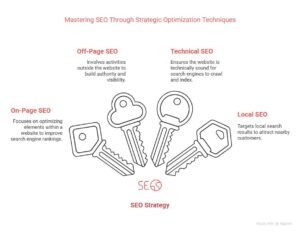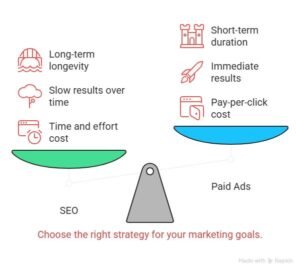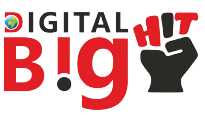In today’s hyper-competitive digital world, the question is no longer “Should I market online?” but rather “How should I market online?” Two of the most effective strategies—SEO vs. Paid Ads Search Engine Optimization (SEO) and Paid Advertising (PPC)—are often pitched against each other. But which one is best for your business?
Whether you’re a startup owner looking to build long-term visibility or a brand aiming for instant traffic, understanding the core differences between SEO and Paid Ads is crucial to making informed decisions.
Understanding SEO (Search Engine Optimization)
SEO is the process of optimizing your website and content to rank higher in organic (unpaid) search engine results. When someone Googles something relevant to your business, the goal is to appear at the top.
Key Components of SEO:
- On-Page SEO: Keyword research, meta descriptions, headers, internal linking
- Off-Page SEO: Backlink building, guest posts, social sharing
- Technical SEO: Website speed, mobile-friendliness, indexability
- Local SEO: Google My Business optimization, local keywords, reviews

Pros of SEO:
- Long-term traffic at a low cost
- Builds authority and trust
- Higher click-through rates (CTR) than ads
- Better ROI over time
Cons of SEO:
- Results take time (3–6 months or more)
- Algorithm updates can affect rankings
- Requires ongoing content and optimization
Understanding Paid Ads (PPC)
Paid Ads refer to advertising on search engines (Google Ads), social platforms (Facebook, Instagram), and other digital channels. You pay for every click or impression based on your target audience and campaign goals.
Types of Paid Ads:
- Search Ads: Appear on Google above organic results
- Display Ads: Banner ads across websites
- Social Media Ads: Instagram, Facebook, LinkedIn promotions
- Video Ads: YouTube or in-app placements
Pros of Paid Ads:
- Instant visibility
- Targeted audience reach
- Great for promotions, launches, or seasonal sales
- Easy to measure and optimize
Cons of Paid Ads:
- Costly in competitive industries
- Traffic drops once the budget stops
- Ad fatigue can reduce performance
SEO vs. Paid Ads: Head-to-Head Comparison
Here’s a quick look at how both compare:
| Criteria | SEO | Paid Ads |
| Cost | Mostly time and effort | Pay-per-click or impression |
| Speed of Results | Slow (3–6 months) | Immediate |
| Longevity | Long-term | Short-term (ends with budget) |
| Trust & Credibility | High (organic listings are trusted) | Lower (ads are marked as sponsored) |
| Click-Through Rate (CTR) | Higher (especially for top results) | Lower compared to organic listings |
| Maintenance | Requires consistent content and updates | Requires budget monitoring and creative refresh |
| Ideal For | Long-term growth and authority building | Short-term campaigns, events, quick results |

When Should You Use SEO?
SEO is a great option if:
- You’re building a brand for the long run
- You have the time and patience to wait for results
- You want to own your traffic instead of renting it
- You’re focused on content marketing and lead generation
Digital Bighit, a top-rated digital marketing company in India, offers end-to-end SEO services—from keyword mapping and content writing to link building and performance tracking.
When Should You Use Paid Ads?
Paid Ads work best when:
- You need quick visibility (like a product launch)
- You have a limited-time offer or event
- You’re targeting a very specific audience
- Your business has a decent marketing budget
At Digital Bighit, we specialize in running high-ROI ad campaigns on Google, Facebook, Instagram, and YouTube with laser-focused targeting and real-time reporting.
SEO vs. Paid Ads Over Time: Traffic Growth Chart
(Chart Description for Word File)
Imagine a line graph with time on the X-axis and website traffic on the Y-axis.
- SEO: Starts slow but rises steadily over months and maintains consistent traffic.
- Paid Ads: Spikes instantly but drops sharply once the ad campaign ends.
This visual highlights that SEO is a marathon, while Paid Ads are a sprint.
Combining Both for Best Results
The truth is: SEO and Paid Ads aren’t enemies—they’re allies. The most successful businesses use both strategically:
- Use Paid Ads for product launches, lead generation, and retargeting
- Invest in SEO for evergreen content and long-term authority
A full-funnel strategy managed by professionals like Digital Bighit ensures you don’t just get traffic—you get results.
FAQs
1. Can I rely only on SEO and ignore Paid Ads?
While SEO is great for long-term gains, ignoring Paid Ads means missing out on quick wins, especially for product launches or promotions.
2. Are Paid Ads worth the investment?
Yes—when done right. A well-targeted ad campaign can deliver immediate results and high ROI, especially in competitive niches.
3. How long does it take for SEO to show results?
Typically, 3 to 6 months depending on your competition, domain authority, and content strategy.
4. Which has a better ROI: SEO or Paid Ads?
Over time, SEO often provides a better return. But Paid Ads can be more effective for immediate conversions or lead generation.
5. Should I hire a digital marketing agency or do it myself?
If you want consistent, measurable growth, hiring a professional agency like Digital Bighit ensures expertise, strategy, and execution—saving you time and maximizing your ROI.
Final Thoughts: Which Should You Choose?
- Choose SEO if you want to play the long game.
- Choose Paid Ads if you need quick, scalable results.
- Choose both if you want to dominate your industry online.
For tailored strategies, transparent reporting, and real results, trust Digital Bighit—your partner in growth.

